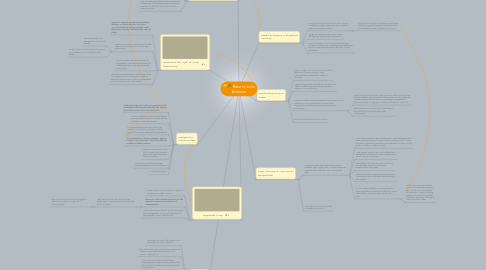
1. Blackness in Columbia
1.1. Columbia has one of the largest black populations in Latin America
1.2. Black slaves were referred to by their owners as "Negros"; Free blacks were referred to as "Libres", meaning free
1.3. In the 1970's Columbian youth began identifying vigorously as blacks; were a small urban intellectual elite of university students and graduates
1.4. Organizations such as the Cimarron and Smith Cordoba's organization were leaders in this movement
1.5. Ultimately, both organizations had a limited impact; never involved those who were classified or classified themselves as blacks
1.6. These movements are important in understanding how people have organized as blacks in columbia
1.7. Serves to analyze the gradual changes in the representations of "Black culture"
2. Zapatista Army
2.1. Most known of contemporary indigenous movements in Latin America
2.2. Grew as a reult of growing mistrust in the Mexican government and a lack of representation
2.2.1. They denied money from the mexican government. They organized their own jobs, water, and land.
2.2.1.1. they shared their stories and struggles to justice threw videos, songs, and documentaries
2.3. People who were protected in international or national legislation as having a set of specific rights based on their historical ties
3. Indigenous Communities
3.1. Indigenous Mapuche Indian communities living in Southern Chile are in battle with the state as they try to reclaim their ancestral lands.
3.2. Chile's indigenous Mapuche community protested against police brutality with the children in rural communities.
3.3. Movements such as the EZLN where the peasants and natives in Chiapas rebelled against the Mexican state and local landlords .
3.4. The Guarani live in Brazil, Paraguay, Bolivia, Uruguay, and Argentina. They face different problem in these societies
3.5. Biofuels company set up by Shell in Brazil plan to source sugar cane from land stolen from the Guarani.
3.6. The Guarani Indians are deeply spiritual people and extremely silent.
3.7. A "land without Evil".
4. Brazil and the Myth of racial democracy
4.1. UNESCO, Brazilian racial theory, has been effective in dismantling the myth of a non-racist national culture in which racial democracy rised and challenge the roles of elites.
4.2. Racial revisionism, to reduce race to class, depriving racial dynamics of their own significance.
4.2.1. scholars wanted to be portrayed as a non racist society
4.2.2. media in latin america played a big role in the development and hiding of racial issues
4.3. Racial formation theory deals with the complexities of Brazilian racial dynamics, understands race as being historically constructed.
4.4. The black movement was a combination of the re-emergence of civil society which open a social movement activity and the politicization of racial identities upon that terrain
5. afro Mexicans
5.1. Black organization compare to those in Brazil due to the Unity and the overall cause which is to look to other experiences and notions of blackness to inform their own positions.
5.1.1. In Mexico afro Mexicans are being driven out and have no economic power.
5.2. The alliance between blacks and indigenous people are significant. Indians have different place that blacks do in the social order of Columbia
5.3. Black are no longer invisible, the smooth maintenance if racial inequality has been disrupted and while blackness has not entered mainstream politics.
5.4. Afro-Mexican population has been pushed to neighboring rural villages known for poverty and dark inhabitants, most blacks had no economic power.
6. Blacks in mexico: a forgotten minority
6.1. Yanga was the first town to free African slaves, founded by Gaspar Yanga who led a rebellion against his Spanish masters. .
6.1.1. Many of the country's mexicanos negro, know that their ancestors arrived in chains on boats that docked at ports in the sate of Veracruz.
6.2. Yanga, on Mexico's Gulf Coast, fought off attempts to retake the settlement.
6.3. Most of Yanga's Afro-Mexican population got moved to neighboring rural villages that are known for their deep poverty and the dark skin of their inhabitants.
7. Re-thinking Race in brazil
7.1. May 13, 1988- The 100th anniversary of the abolition of slavery in Brazil; many Afro-Brazilians protested the "farce of abolition"
7.2. UNESCO sponsored research set new terms for debate, establishing (not without dispute) a new racial "re-invisionism"
7.3. UNESCO studies constantly practiced reductionism; they viewed race as a manifestation of some other, supposedly more fundamental, social process or relationship
7.3.1. Full of insights into Brazilian Racial Dynamics; also had significant limitations-often reduced race to class Brazilian scholar Thales de Asevedo believed the process of race being subordinated to class was already in progress; could be considered a social fact
7.3.2. Reductionism occurs when the independence and depth of racial phenomena goes unrecognized
7.4. Race was interpreted in terms of class
8. Latin America in Asia-Pacific Perspective
8.1. Long and continuous historical connection between large region (Latin American coastline) of first Iberian, and later Latin, America and Asia
8.1.1. Asian labor migrations were initially tied in with developments in Latin America as part of a larger world economy; result of need for labor in plantation economies once abolition of slaery cut off sources of labor in Atlantic Ocean
8.1.2. "The Spanish-Pacific" was a well established geographic and political entity well before the arrival of North Europeans
8.1.3. The reality of the Spanish-Asian Pacific was renewed by Mexican and Peruvian independence from Spain
8.1.4. International labor migration and population movements from Asia played a pivotal role in this creation
8.1.5. Chinese labor initially the most prominent in these population movements at the turn of the 20th century; Japanese labor would come later
8.1.5.1. In the 1870's escaped coolies and free Chinese were among the pioneers who penetrated the Peruvian Amazon, building settlements; introducing trade activities; cultivating rice, beans, sugar and other crops
